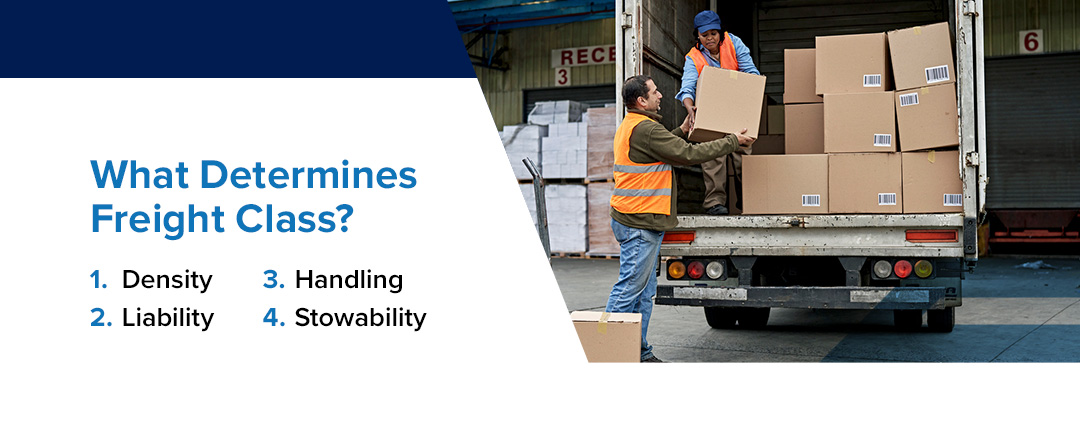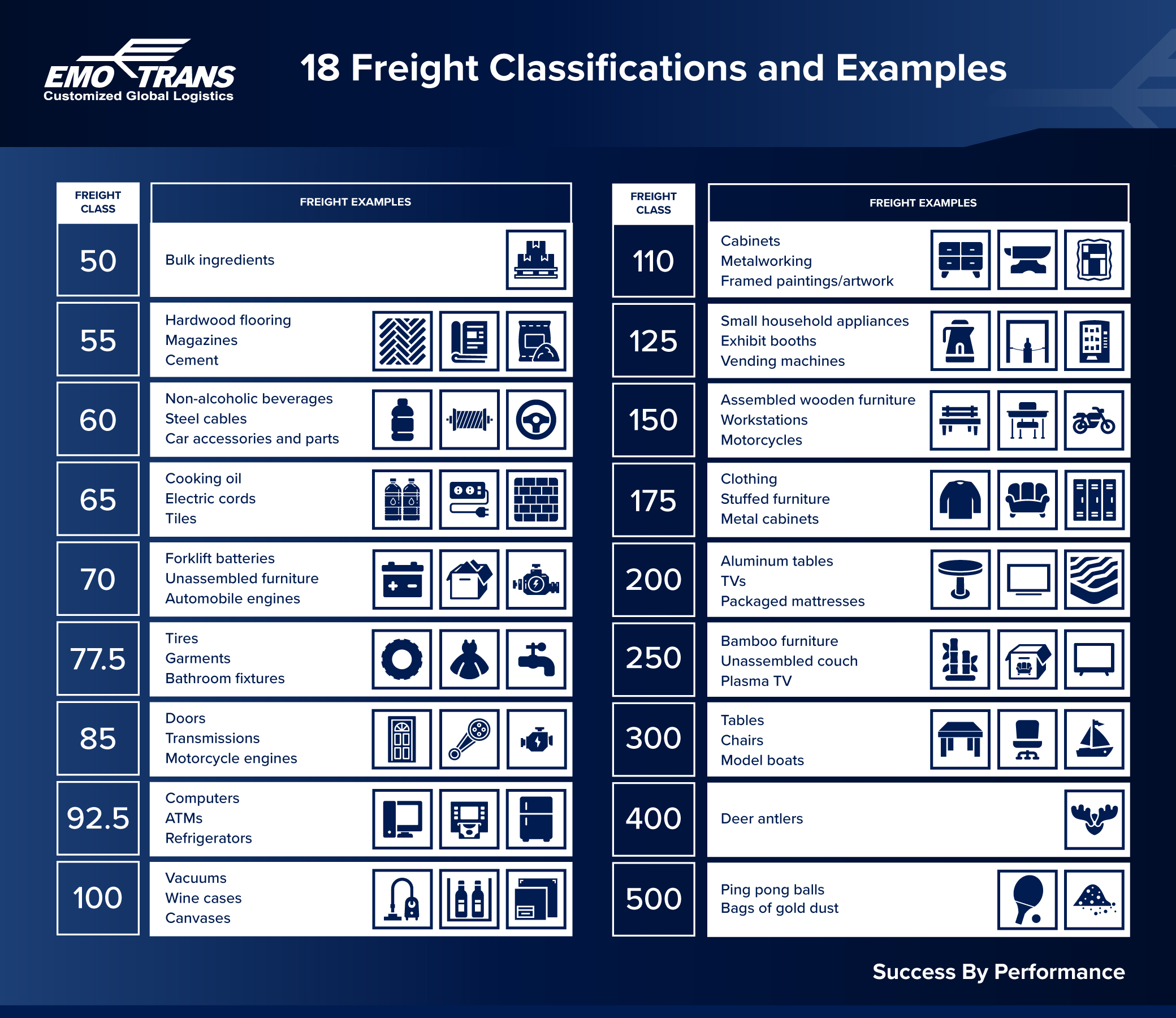
Whenever you request rates and book less-than-truckload (LTL) shipping services, the carrier will require the proper freight classification for the cargo to provide an accurate quote.
This step eliminates significant and unexpected freight charges, which can impact your plans, time and resources. Moreover, understanding freight classes can assist you in making claims or seeking compensation when shipments are lost, stolen or damaged in transit.
This guide can help you with the essential aspects of freight classes and prepare you for a safe and efficient shipping experience.
What Is Freight Class?
Freight class is a classification system for intrastate, interstate and international commerce movement of less-than-truckload shipments. In other words, it is a standardized method for defining the price for LTL freight based on ease of movement. Considering that many variations of commodities are shipped together in LTL shipments, there is a need for a standardized comparative evaluation and that is what freight class offers.
The National Motor Freight Traffic Association (NMFTA) defines various freight classes by allocating a National Motor Freight Classification (NMFC) to each product type. The NMFC corresponds to a specific freight class number for LTL shipments.
As LTL shipping involves different products with unique liabilities, densities and handling considerations, the NMFC offers a common ground for carriers and shippers to negotiate freight rates and logistics for efficient and productive shipping.
What Is the Difference Between Freight Classes and NMFC Codes?
Each product or commodity has both a freight class and an NMFC code. While the freight class represents a category of items, the NMFC code relates to specific commodities within each freight class. Therefore, commodities may have different NMFC codes but may belong to the same freight class.

What Determines Freight Class?
There are four primary metrics for determining freight classes:
1. Density
Freight density is the measurable space an item requires in relation to its weight, measured in pounds per cubic foot. Typically, cargo with higher densities falls within the lower classes, while those with lower densities fall within the higher categories. Compact, higher-density items are usually cheaper to ship than lighter, bulky ones.
2. Liability
Liability is the commodity’s value and potential risk of damage, theft, or loss or the risk of causing damage to other items in transit. The greater the risk, the higher the freight class. Perishable commodities and hazardous freights typically have higher liabilities and costs.
3. Handling
Some items require more care or special instructions than others when loading, unloading and transporting across destinations. The products’ shape, weight, and unique restrictions, such as special attention, fragility, and hazardous properties, may determine these additional requirements.
Items that demand more than the standard shipping procedures usually fall within the higher freight classifications and are more expensive to ship.
4. Stowability
Stowability relates to how your item can be transported with others, considering factors like government regulations and particular carrier policies. Commodities that are flammable, perishable or hazardous and those that interfere with the transportation or convenience of others usually have higher freight classifications. Freight that is packaged to become uniform and stackable is easier and more efficient to stow in a shipment.
What Are the Freight Classes?

Below are the 18 freight classifications, ranging from 50 to 500:
- Freight class 50: Freight class 50 is known as clean freight. It has a weight range per cubic foot of 50 pounds and above. An example of a commodity within this class is bulk ingredients.
- Freight class 55: Freight class 55 has a weight range per cubic foot between 35 and 50 pounds. Examples of commodities within this class are hardwood flooring, magazines and cement.
- Freight class 60: Freight class 60 has a weight range per cubic foot between 30 and 35 pounds. Examples of commodities within this class are non-alcoholic beverages, steel cables and car accessories and parts.
- Freight class 65: Freight class 65 has a weight range per cubic foot between 22.5 and 30 pounds. Examples of commodities within this class are cooking oil, electric cords and tiles.
- Freight class 70: Freight class 70 has a weight range per cubic foot between 15 and 22.5 pounds. Examples of commodities within this class are forklift batteries, unassembled furniture and automobile engines.
- Freight class 77.5: Freight class 77.5 has a weight range per cubic foot between 13.5 and 15 pounds. Examples of commodities within this class are tires, garments and bathroom fixtures.
- Freight class 85: Freight class 85 has a weight range per cubic foot between 12 and 13.5 pounds. Examples of commodities within this class are doors, transmissions and motorcycle engines.
- Freight class 92.5: Freight class 92.5 has a weight range per cubic foot between 10.5 and 12 pounds. Examples of commodities within this class are computers, ATMs and refrigerators.
- Freight class 100: Freight class 100 has a weight range per cubic foot between 9 and 10.5 pounds. Examples of commodities within this class are vacuums, wine cases and canvases.
- Freight class 110: Freight class 110 has a weight range per cubic foot between 8 and 9 pounds. Examples of commodities within this class are cabinets, metalworking and framed paintings and artwork.
- Freight class 125: Freight class 125 has a weight range per cubic foot between 7 and 8 pounds. Examples of commodities within this class are small household appliances, exhibit booths and vending machines.
- Freight class 150: Freight class 150 has a weight range per cubic foot between 6 and 7 pounds. Examples of commodities within this class are assembled wooden furniture, workstations and motorcycles.
- Freight class 175: Freight class 175 has a weight range per cubic foot between 5 and 6 pounds. Examples of commodities within this class are clothing, stuffed furniture and metal cabinets.
- Freight class 200: Freight class 200 has a weight range per cubic foot between 4 and 5 pounds. Examples of commodities within this class are aluminum tables, TVs and packaged mattresses.
- Freight class 250: Freight class 250 has a weight range per cubic foot between 3 and 4 pounds. Examples of commodities within this class are bamboo furniture, unassembled couch and plasma TV.
- Freight class 300: Freight class 300 has a weight range per cubic foot between 2 and 3 pounds. Examples of commodities within this class are tables, chairs and model boats.
- Freight class 400: Freight class 400 has a weight range per cubic foot between 1 and 2 pounds. An example of a commodity within this class is deer antlers.
- Freight class 500: Freight class 500 has a weight range per cubic foot of less than 1 pound. Examples of commodities within this class are ping pong balls and bags of gold dust.
What Should You Know About Density-Based Freight Classes?
Without significant handling, liability or stowing characteristics, density becomes the primary determining factor for assigning classes. The NMFTA’s Commodity Classification Standards Board has developed guidelines for determining freight class based on shipment density. The guidelines assume an average density among freights within the class and ignore problems with handling, liability and stowing.
EMO Trans Is Your Trusted Transport and Logistics Partner
EMO Trans is a single-source transport company with nearly six decades of experience in domestic and international logistics solutions. We allow you to customize your shipments and tailor quotes to meet your needs. Learn more about our services by contacting us today.

